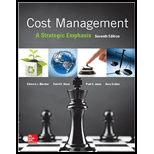
Compute the following ratios for Incorporation, Y B for 2012 and 2013.
- a. Gross margin percent
- b. Return assets
- c. Return on equity
Explanation of Solution
Analysis of the financial ratio utilizes the ratios of financial statements to evaluate the performance of the firm. Two common performance measures include liquidity and profitability. The four key profitability ratios are gross margin percent, return on assets, return on equity, and earnings per share.
Profitability ratios are a class of financial metrics that are used over time to evaluate the ability of a business to generate earnings relative to its revenue, operating costs,
- a. Gross margin percent
The Gross Margin Ratio is a profitability ratio, which is also known as the gross profit margin ratio. It shows how much profit a firm makes after paying off its cost of goods sold.
- a. Calculate Gross margin percent ratio for Incorporation, Y B.
For 2013,
Gross margin for 2013 is $3,583.
Sales in 2013 are $13,084.
The formula to calculate gross margin ratio is:
Calculate gross margin % ratio:
Hence, the gross margin ratio for 2013 is 27.4%.
For 2012,
Gross margin for 2012 is $3,780
Sales in 2012 are $13,632.
The formula to calculate gross margin ratio is:
Calculate gross margin % ratio:
Hence, the gross margin ratio for 2013 is 27.7%.
- b. Return on assets
Return on assets is a profitability ratio that gives a company how much profit a business can generate from its assets. It initiatives how efficiently a company manages to generate profits from its economic resources or assets in its balance sheet
For 2013
Net income in 2013 is $1,091.
Total assets in 2013 are $8,695.
Total assets in 2012 are $9,013.
Calculate average total assets:
The formula to calculate the return in assets ratio is:
Calculate return in assets ratio for 2013:
Hence, the return in assets for 2013 is 12.3%.
For 2012
Net income in 2012 is $1,597.
Total assets in 2012 are $9,013.
Total assets in 2011 are $8,834.
Calculate average total assets:
The formula to calculate the return in assets ratio is:
Calculate return in assets ratio for 2012:
Hence, the return in assets for 2012 is 17.9%.
- c. Return on equity
The return on equity ratio essentially measures the rate of return received by the owners of a company's common stock on their shareholdings. It means how efficient a company is in producing returns on the investment that its shareholders have received.
The formula to calculate the return on equity ratio is:
Net income in 2013 is $1,091.
Shareholder’s equity in 2013 is $2,229.
Shareholder’s equity in 2012 is $2,253.
Calculate average shareholder’s equity:
Calculate return on equity ratio for 2013:
Hence, the return on equity ratio for 2013 is 48.7%.
The formula to calculate the return on equity ratio is:
Net income in 2012 is $1,597.
Shareholder’s equity in 2012 is $2,253.
Shareholder’s equity in 2011 is $1,916.
Calculate average shareholder’s equity:
Calculate return on equity ratio for 2012:
Hence, the return on equity ratio for 2012 is 76.6%.
It is concluded that, from 2012 until 2013, the gross margin ratio is fairly constant. The large decline in revenue in 2013 far exceeded the decline in assets, thus drastically reducing return on assets. Stockholders ' equity was fairly stable, resulting in a substantial decrease in return on equity.
Want to see more full solutions like this?
Chapter 20 Solutions
Cost Management: A Strategic Emphasis
- Hello tutor please given General accounting question answer do fast and properly explain all answerarrow_forwardQuintana Corporation projected current year sales of 42,000 units at a unit sale price of $32.50. Actual current year sales were 39,500 units at $33.75 per unit. Actual variable costs, budgeted at $22.75 per unit, totaled $21.90 per unit. Budgeted fixed costs totaled $375,000, while actual fixed costs amounted to $392,000. What is the sales volume variance for total revenue? I want answerarrow_forwardWhat is hemingway corporation taxable income?arrow_forward
- Please given correct answer for General accounting question I need step by step explanationarrow_forwardArmour vacation cabin was destroyed by a wildfire. He had purchased the cabin 14 months ago for $625,000. He received $890,000 from his insurance company to replace the cabin. If he fails to rebuild the cabin or acquire a replacement property in the required time, how much gain must he recognize on this conversion? A. $375,000 B. $160,000 C. $265,000 D. $0 E. None of the above helparrow_forwardI am looking for the correct answer to this financial accounting question with appropriate explanations.arrow_forward

 AccountingAccountingISBN:9781337272094Author:WARREN, Carl S., Reeve, James M., Duchac, Jonathan E.Publisher:Cengage Learning,
AccountingAccountingISBN:9781337272094Author:WARREN, Carl S., Reeve, James M., Duchac, Jonathan E.Publisher:Cengage Learning, Accounting Information SystemsAccountingISBN:9781337619202Author:Hall, James A.Publisher:Cengage Learning,
Accounting Information SystemsAccountingISBN:9781337619202Author:Hall, James A.Publisher:Cengage Learning, Horngren's Cost Accounting: A Managerial Emphasis...AccountingISBN:9780134475585Author:Srikant M. Datar, Madhav V. RajanPublisher:PEARSON
Horngren's Cost Accounting: A Managerial Emphasis...AccountingISBN:9780134475585Author:Srikant M. Datar, Madhav V. RajanPublisher:PEARSON Intermediate AccountingAccountingISBN:9781259722660Author:J. David Spiceland, Mark W. Nelson, Wayne M ThomasPublisher:McGraw-Hill Education
Intermediate AccountingAccountingISBN:9781259722660Author:J. David Spiceland, Mark W. Nelson, Wayne M ThomasPublisher:McGraw-Hill Education Financial and Managerial AccountingAccountingISBN:9781259726705Author:John J Wild, Ken W. Shaw, Barbara Chiappetta Fundamental Accounting PrinciplesPublisher:McGraw-Hill Education
Financial and Managerial AccountingAccountingISBN:9781259726705Author:John J Wild, Ken W. Shaw, Barbara Chiappetta Fundamental Accounting PrinciplesPublisher:McGraw-Hill Education





